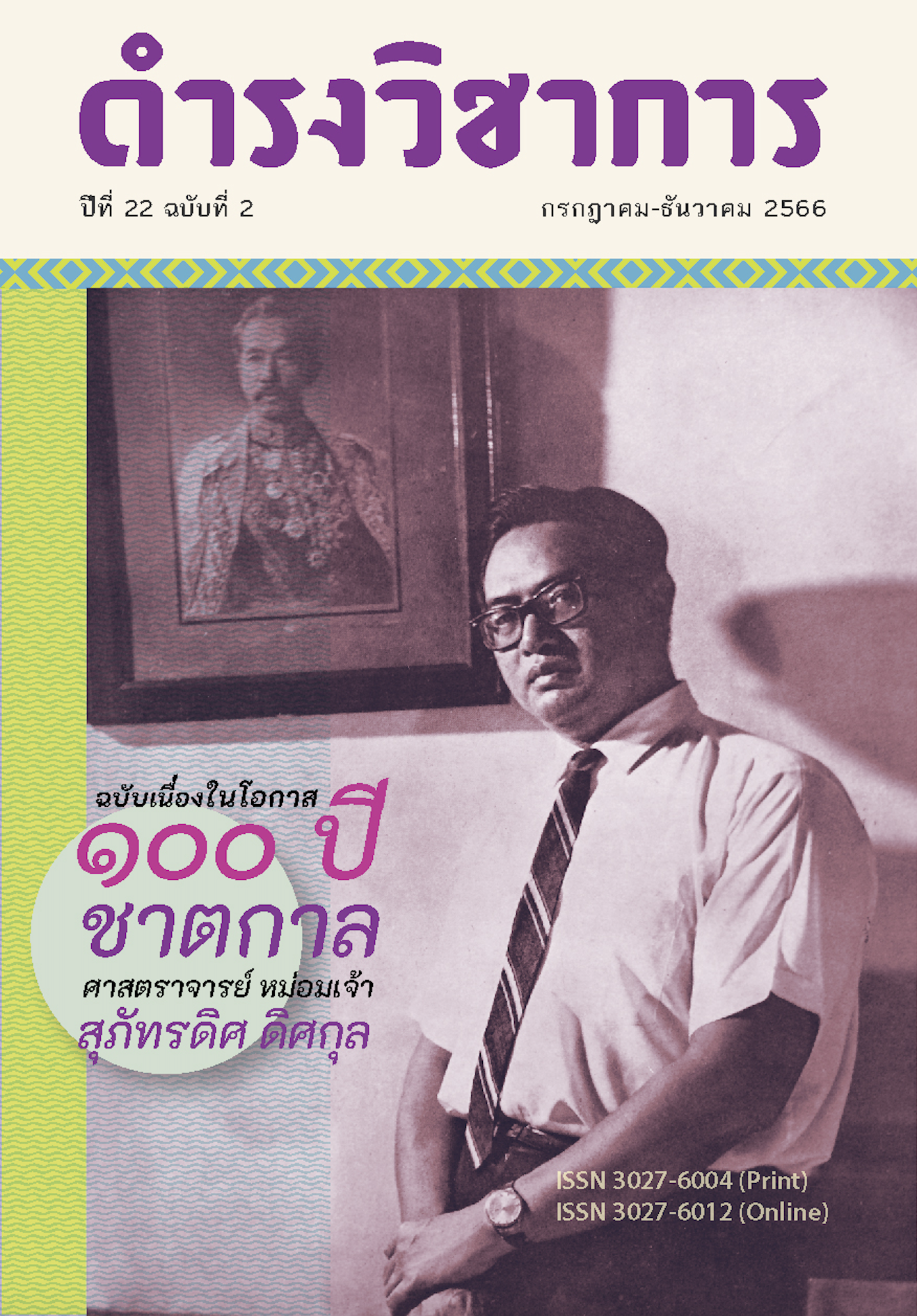ความเชื่อแบบผสมผสานระหว่างพุทธและพราหมณ์จากหลักฐานจารึกภาษาสันสกฤต ที่พบในประเทศไทยและกัมพูชา
คำสำคัญ:
เถรวาท, มหายาน, ไศวนิกาย, ไวษณวนิกายบทคัดย่อ
จากหลักฐานที่เป็นรูปเคารพ คือ พระพุทธรูปและเทวรูปในศาสนาพราหมณ์ชี้ว่าทั้งสองศาสนา มาถึงดินแดนเอเชียตะวันออกเฉียงใต้เมื่อราวพุทธศตวรรษที่ 9 (คริสต์ศตวรรษที่ 4) ในอาณาจักรฟูนัน (Funan) มีหลักฐานจารึกภาษาสันสกฤตที่ชี้ว่า ศาสนาพุทธ ที่ใช้ภาษาสันสกฤตเจริญรุ่งเรืองในพุทธศตวรรษที่ 11 (คริสต์ศตวรรษที่ 6) ในขณะเดียวกันก็มีหลักฐานจารึกที่แสดงว่ามีการนับถือศาสนาพราหมณ์ไวษณวนิกายด้วย ในภาคกลางของประเทศไทย ซึ่งเชื่อว่าเป็นศูนย์กลางอาณาจักรทวารวดี พบจารึกภาษาบาลีอายุประมาณ พุทธศตวรรษที่ 12-13 (คริสต์ศตวรรษที่ 6-7) เป็นข้อความที่คัดมาจากพระไตรปิฎก ภาษาบาลีแทบทั้งหมด แสดงว่าพระพุทธศาสนาในดินแดนแถบนี้เป็นนิกายเถรวาทที่ยึดมั่นในคัมภีร์พระไตรปิฏกภาษาบาลี ในขณะเดียวกัน ในช่วงเวลานั้นก็พบจารึกภาษาสันสกฤตแต่พบจำนวนน้อยมาก ซึ่งชี้ว่ามีการนับถือศาสนา พราหมณ์เช่นเดียวกัน ในสมัยต่อมามีจารึกจำนวนไม่น้อยที่แสดงถึงการผสมผสานความเชื่อระหว่างศาสนาพุทธ และศาสนาพราหมณ์ ในดินแดนที่อยู่ประเทศไทยและกัมพูชาในยุคนั้น
เอกสารอ้างอิง
ภาษาไทย
กรมศิลปากร, (2529). จารึกในประเทศไทยเล่ม 1. กรุงเทพฯ : กรมศิลปากร.
________________________(2529) จารึกในประเทศไทยเล่ม 3. กรุงเทพฯ : กรมศิลปากร.
กวีศักดิ์ วาปีกุลเศษฐ์, พระมหา (2564). จารึกสุไหงมาส 2 ใน จารึกที่สำคัญในอินเดียและเอเชียตะวันออกเฉียงใต้ เล่ม 1, สมบัติ มั่งมีสุขศิริ เป็นบรรณาธิการ. กรุงเทพฯ: ศูนย์สันสกฤตศึกษา ร่วมกับภาควิชา ภาษาตะวันออก คณะโบราณคดี มหาวิทยาลัยศิลปากรโดยความอุปถัมภ์กระทรวงวัฒนธรรมประเทศ อินเดีย.
จิรพัฒน์ ประพันธ์วิทยา “ปรัชญาปารมิตาสูตฺร” ใน วารสารไทย-ภารต ฉบับที่ 37 ปีที่ 45 พ.ศ.2564
________และ Sato Keiko, (2564). จารึก เมืองเสมา(K.1141) ใน จารึกที่สำคัญในอินเดียและ เอเชียตะวันออกเฉียงใต้ เล่ม 1, สมบัติ มั่งมีสุขศิริ เป็นบรรณาธิการ กรุงเทพฯ: ศูนย์สันสกฤตศึกษา ร่วมกับภาควิชาภาษาตะวันออก คณะโบราณคดี มหาวิทยาลัยศิลปากร โดยความอุปถัมภ์กระทรวง วัฒนธรรมประเทศอินเดีย.
สมบัติ มั่งมีสุขศิริ เป็นบรรณาธิการ (2564). จารึกที่สำคัญในอินเดียและเอเชียตะวันออกเฉียงใต้ เล่ม 1, กรุงเทพฯ:
ศูนย์สันสกฤตศึกษาร่วมกับภาควิชาภาษาตะวันออกคณะโบราณคดีมหาวิทยาลัยศิลปากร โดยความอุปถัมภ์กระทรวงวัฒนธรรมประเทศอินเดีย.
นวพรรณ ภัทรมูล (ผู้รวบรวมข้อมูล) จารึกวัดจงกอ ค้นจาก https://db.sac.or.th/inscriptions/inscribe/detail/2538 วันที่ 16 ตุลาคม 2566
ภาษาอังกฤษ
Cœdès, G, ed., (1942). Inscriptions du Cambodge Volume II. Paris: Ecole Francaise D’Extreme-
Orient.
________ed., (1954).Inscriptions du Cambodge Volume VI. Paris: Ecole Francaise D’Extreme-
Orient.
_________(1975). The Indianized States of Southeast Asia, edited by Water F.Vella, translated by Susan Brown Cowing. Canberra: Australian National University Press.
Krairiksh, Piriya. (1974). Buddhist Folk Tales Depicted at Chula Pathon Cedi. Bangkok: Prachandra Printing Press.
Lavy, Paul A. and Clarke, Wesley, (2015). Integrating the Phong Tuek Viṣṇu: The Archaeology and
Art History of a Forgotten Image in Journal of the Siam Society, Vol.103.
Majumdar, R.C.(1953). Inscriptions of Kambuja. Calcutta: The Aseatic Society.
Mangmeesukhsiri, Sombat, ed., (2021). Select Inscriptions in India and Southeast Asia volume I. Bangkok: Sanskrit studies centre in Association with the Department of Oriental Languages, Faculty of Archaeology.
Prapandvidya, Chirapat, (1990). The Sabbāk inscription, Evidence of an Early Vajrayana Buddhist
Presence in Thailand. In the Journal Siam Society, Volume 78, part II.
ดาวน์โหลด
เผยแพร่แล้ว
ฉบับ
ประเภทบทความ
สัญญาอนุญาต
ลิขสิทธิ์ (c) 2023 ดำรงวิชาการ

อนุญาตภายใต้เงื่อนไข Creative Commons Attribution-NonCommercial-NoDerivatives 4.0 International License.
บทความนี้เป็นผลงานของข้าพเจ้าแต่เพียงผู้เดียว และ/หรือเป็นผลงานของข้าพเจ้าและผู้ร่วมงาน ตามชื่อที่ระบุในบทความจริง และเป็นผลงานที่มิได้ถูกนำเสนอหรือตีพิมพ์ที่ใดมาก่อน





